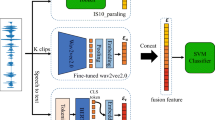Abstract
Speech recognition technology is an important means to help patients with Parkinson’s Disease (PD) speech disorder to control the disease, which can effectively improve the objectivity of doctors’ diagnoses and the quality of life of patients. However, the existing research lacks the comprehensive consideration of time-frequency domain information. To overcome this problem, we propose a Time-Frequency Fusion Network(TF-FusNet) model, capturing long temporal dependencies and frequency domain representation information of speech. Firstly, we design a time-frequency domain feature fusion approach to combine the temporal information and frequency domain representations for speech classification. Secondly, we extract five different speech cepstral coefficient features to provide multiple perspectives of disease understanding. Thirdly, we design a decision layer based on a voting strategy for finalizing the speech classification results. Experiments on the London King’s College Mobile Device Voice Recording (MDVR-KCL) and the Italian Parkinson’s Voice Database (IPVS) datasets show that TF-FusNet achieves classification accuracies of 98.45% and 99.63%, respectively, outperforming other SOTA models.
Access this chapter
Tax calculation will be finalised at checkout
Purchases are for personal use only
Similar content being viewed by others
References
Aftab, A., Morsali, A., Ghaemmaghami, S., Champagne, B.: Light-sernet: a lightweight fully convolutional neural network for speech emotion recognition. In: ICASSP 2022-2022. IEEE (2022)
Demir, F., Sengur, A., Ari, A., Siddique, K., Alswaitti, M.: Feature mapping and deep long short term memory network-based efficient approach for Parkinson’s disease diagnosis. IEEE Access (2021)
Dewi, S.P., Prasasti, A.L., Irawan, B.: Analysis of IFCC feature extraction in baby crying classification using KNN. In: 2019 IEEE International Conference on IoTaIS. IEEE (2019)
Dimauro, G., Girardi, F.: Italian Parkinson’s voice and speech (2019)
Eyigoz, E., et al.: From discourse to pathology: Automatic identification of Parkinson’s disease patients via morphological measures across three languages. Cortex (2020)
Filippi, M., et al.: Longitudinal brain connectivity changes and clinical evolution in Parkinson’s disease. Molecular Psychiatry (2021)
Guo, J., et al.: CMT: convolutional neural networks meet vision transformers. In: Proceedings of the IEEE/CVF Conference on Computer Vision and Pattern Recognition (2022)
Guo, Y., Xiong, X., Liu, Y., Xu, L., Li, Q.: A novel speech emotion recognition method based on feature construction and ensemble learning. PLoS ONE 17(8), e0267132 (2022)
Gupta, H., Gupta, D.: LPC and LPCC method of feature extraction in speech recognition system. In: 2016 6th International Conference-Cloud System and Big Data Engineering. IEEE (2016)
Jaeger, H., Trivedi, D., Stadtschnitzer, M.: Mobile device voice recordings at King’s College London (MDVR-KCL) from both early and advanced Parkinson’s disease patients and healthy controls. Zenodo (2019)
Latif, S., et al.: Dopamine in Parkinson’s disease. Clin. Chim. Acta (2021)
Moro-Velazquez, L., Gomez-Garcia, J.A., Arias-Londoño, J.D., Dehak, N., Godino-Llorente, J.I.: Advances in Parkinson’s disease detection and assessment using voice and speech: a review of the articulatory and phonatory aspects. Biomed. Signal Process. Control 66, 102418 (2021)
Nasiri, A., Hu, J.: Soundclr: contrastive learning of representations for improved environmental sound classification. arXiv preprint arXiv:2103.01929 (2021)
Rejaibi, E., Komaty, A., Meriaudeau, F., Agrebi, S., Othmani, A.: MFCC-based recurrent neural network for automatic clinical depression recognition and assessment from speech. Biomed. Signal Process. Control 71, 103107 (2022)
Shafeena, M., Vijayan, S.: Parkinson’s disease prognosis using the resnet-50 model from speech features. In: 2022 International Conference on ICISTSD. IEEE (2022)
Suresh, A., Jain, A., Mathur, K., Gambhir, P.: Comparison of modelling ASR system with different features extraction methods using sequential model. In: Dev, A., Agrawal, S.S., Sharma, A. (eds.) AIST 2021. CCIS, vol. 1546, pp. 47–61. Springer, Cham (2022). https://doi.org/10.1007/978-3-030-95711-7_5
Ye, J.X., et al.: Gm-tcnet: gated multi-scale temporal convolutional network using emotion causality for speech emotion recognition. Speech Communication (2022)
Ye, J., Wen, X.C., Wei, Y., Xu, Y., Liu, K., Shan, H.: Temporal modeling matters: a novel temporal emotional modeling approach for speech emotion recognition. In: ICASSP 2023-2023. IEEE (2023)
Zhu, W., Li, X.: Speech emotion recognition with global-aware fusion on multi-scale feature representation. In: ICASSP 2022-2022. IEEE (2022)
Acknowledgments
This work was supported by the Natural Science Foundation of Shandong Province under Grant No. ZR2021QF084, National Natural Science Foundation of China under Grant No. 62106117, China Postdoctoral Science Foundation under Grant No.2022M711741 and Shandong Province Higher Education Institutions Youth Innovation and Technology Support Program (2023KJ365).
Author information
Authors and Affiliations
Corresponding author
Editor information
Editors and Affiliations
Rights and permissions
Copyright information
© 2025 The Author(s), under exclusive license to Springer Nature Singapore Pte Ltd.
About this paper
Cite this paper
Ren, T., Yu, W., Chen, M., Zhao, A., Zhou, H. (2025). TF-FusNet: A Novel Framework for Parkinson’s Disease Detection via Time-Frequency Domain Fusion. In: Wong, D.F., Wei, Z., Yang, M. (eds) Natural Language Processing and Chinese Computing. NLPCC 2024. Lecture Notes in Computer Science(), vol 15360. Springer, Singapore. https://doi.org/10.1007/978-981-97-9434-8_7
Download citation
DOI: https://doi.org/10.1007/978-981-97-9434-8_7
Published:
Publisher Name: Springer, Singapore
Print ISBN: 978-981-97-9433-1
Online ISBN: 978-981-97-9434-8
eBook Packages: Computer ScienceComputer Science (R0)





